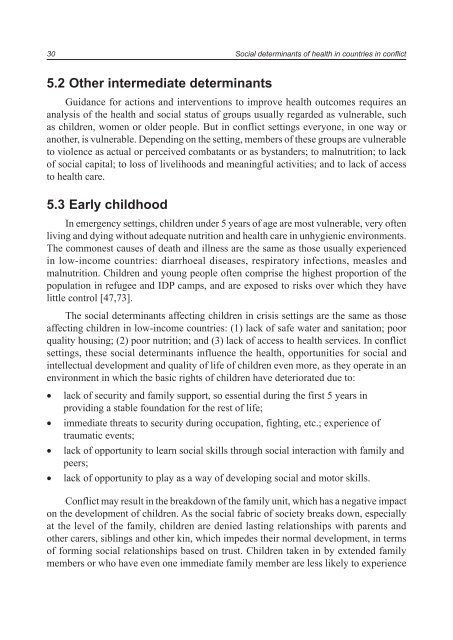Social determinants of health in countries in conflict - What is GIS ...
Social determinants of health in countries in conflict - What is GIS ...
Social determinants of health in countries in conflict - What is GIS ...
You also want an ePaper? Increase the reach of your titles
YUMPU automatically turns print PDFs into web optimized ePapers that Google loves.
30 <strong>Social</strong> <strong>determ<strong>in</strong>ants</strong> <strong>of</strong> <strong>health</strong> <strong>in</strong> <strong>countries</strong> <strong>in</strong> <strong>conflict</strong><br />
5.2 Other <strong>in</strong>termediate <strong>determ<strong>in</strong>ants</strong><br />
Guidance for actions and <strong>in</strong>terventions to improve <strong>health</strong> outcomes requires an<br />
analys<strong>is</strong> <strong>of</strong> the <strong>health</strong> and social status <strong>of</strong> groups usually regarded as vulnerable, such<br />
as children, women or older people. But <strong>in</strong> <strong>conflict</strong> sett<strong>in</strong>gs everyone, <strong>in</strong> one way or<br />
another, <strong>is</strong> vulnerable. Depend<strong>in</strong>g on the sett<strong>in</strong>g, members <strong>of</strong> these groups are vulnerable<br />
to violence as actual or perceived combatants or as bystanders; to malnutrition; to lack<br />
<strong>of</strong> social capital; to loss <strong>of</strong> livelihoods and mean<strong>in</strong>gful activities; and to lack <strong>of</strong> access<br />
to <strong>health</strong> care.<br />
5.3 Early childhood<br />
In emergency sett<strong>in</strong>gs, children under 5 years <strong>of</strong> age are most vulnerable, very <strong>of</strong>ten<br />
liv<strong>in</strong>g and dy<strong>in</strong>g without adequate nutrition and <strong>health</strong> care <strong>in</strong> unhygienic environments.<br />
The commonest causes <strong>of</strong> death and illness are the same as those usually experienced<br />
<strong>in</strong> low-<strong>in</strong>come <strong>countries</strong>: diarrhoeal d<strong>is</strong>eases, respiratory <strong>in</strong>fections, measles and<br />
malnutrition. Children and young people <strong>of</strong>ten compr<strong>is</strong>e the highest proportion <strong>of</strong> the<br />
population <strong>in</strong> refugee and IDP camps, and are exposed to r<strong>is</strong>ks over which they have<br />
little control [47,73].<br />
The social <strong>determ<strong>in</strong>ants</strong> affect<strong>in</strong>g children <strong>in</strong> cr<strong>is</strong><strong>is</strong> sett<strong>in</strong>gs are the same as those<br />
affect<strong>in</strong>g children <strong>in</strong> low-<strong>in</strong>come <strong>countries</strong>: (1) lack <strong>of</strong> safe water and sanitation; poor<br />
quality hous<strong>in</strong>g; (2) poor nutrition; and (3) lack <strong>of</strong> access to <strong>health</strong> services. In <strong>conflict</strong><br />
sett<strong>in</strong>gs, these social <strong>determ<strong>in</strong>ants</strong> <strong>in</strong>fluence the <strong>health</strong>, opportunities for social and<br />
<strong>in</strong>tellectual development and quality <strong>of</strong> life <strong>of</strong> children even more, as they operate <strong>in</strong> an<br />
environment <strong>in</strong> which the basic rights <strong>of</strong> children have deteriorated due to:<br />
•<br />
•<br />
•<br />
•<br />
lack <strong>of</strong> security and family support, so essential dur<strong>in</strong>g the first 5 years <strong>in</strong><br />
provid<strong>in</strong>g a stable foundation for the rest <strong>of</strong> life;<br />
immediate threats to security dur<strong>in</strong>g occupation, fight<strong>in</strong>g, etc.; experience <strong>of</strong><br />
traumatic events;<br />
lack <strong>of</strong> opportunity to learn social skills through social <strong>in</strong>teraction with family and<br />
peers;<br />
lack <strong>of</strong> opportunity to play as a way <strong>of</strong> develop<strong>in</strong>g social and motor skills.<br />
Conflict may result <strong>in</strong> the breakdown <strong>of</strong> the family unit, which has a negative impact<br />
on the development <strong>of</strong> children. As the social fabric <strong>of</strong> society breaks down, especially<br />
at the level <strong>of</strong> the family, children are denied last<strong>in</strong>g relationships with parents and<br />
other carers, sibl<strong>in</strong>gs and other k<strong>in</strong>, which impedes their normal development, <strong>in</strong> terms<br />
<strong>of</strong> form<strong>in</strong>g social relationships based on trust. Children taken <strong>in</strong> by extended family<br />
members or who have even one immediate family member are less likely to experience<br />
SDH-chapters-<strong>countries</strong> <strong>in</strong> <strong>conflict</strong>-7 Oct.<strong>in</strong>dd 30 08/10/2008 14:24:50

















